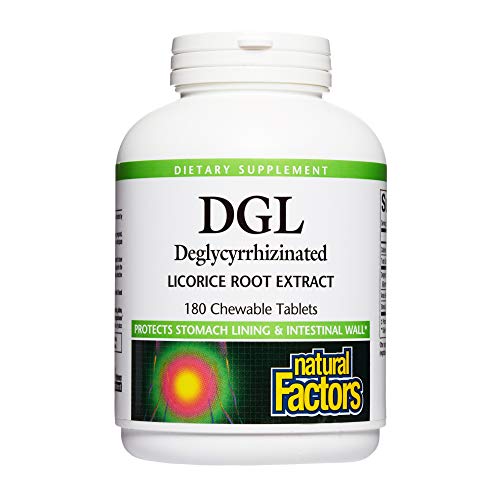Licorice belongs to the Fabaceae family and covers several types of plants with the common name Glycyrrhiza. The word glycyrrhiza is derived from Greek and means “sweet root.”
The herb has been used in Greek medicine for the treatment of pectoral and respiratory diseases as well as for the prevention of Addison's disease. Its use is quite common with sweets and candies because of licorice’s strong sweetness.
Top 5 Best Selling Licorice Supplements
Product | Name | Buy on iHerb | Buy on Amazon |
|---|---|---|---|
#1 Nature's Way DGL Licorice | |||
#2 Now Foods Licorice Root | |||
#3 Natural Factors DGL Licorice Root | |||
#4 Planetary Herbals DGL Licorice Root | |||
#5 Solaray Organically Grown Licorice |
The Main Benefits of Licorice are:
- Licorice has strong antioxidant properties, it reduces by nearly 20% the oxidation of bad cholesterol with the long-term intake of 6 months.
- Licorice has been used in traditional medicine for respiratory and lung diseases.
- Licorice possesses antibacterial properties.
- Helps soothe stomach irritation; digestive system support.
What Is Licorice (Sweet Root)
Licorice has been successfully used in traditional Chinese medicine for the treatment of digestive, heart, and respiratory problems, as well as to promote overall health.
The herb has been used in Greek medicine for the treatment of pectoral and respiratory diseases as well as for the prevention of Addison's disease. Its use is quite common with sweets and candies because of licorice’s strong sweetness.
Licorice belongs to the Fabaceae family and covers several types of plants with the common name Glycyrrhiza. The word glycyrrhiza is derived from Greek and means “sweet root.”
Glycyrrhizic acid is distinguished by its sweetness and is nearly 50 times sweeter than regular sugar. Perhaps the most important active ingredient in licorice is glycyrrhizin, which is actually the main culprit for the sweet taste of the herb.
Glycyrrhizin accounts for between 2 and 15% of the dry weight of the root, but the content in water-alkaline extract could reach 9.1 %. It is the most important component of the herb because of the high percentage of its content and bioactivity in the human body.
Glycyrrhizin is also the main culprit for some of the negative effects of licorice, such as the lowering of testosterone and increasing of cortisol. Therefore, you can find on the market, although more rarely, extracts with a minimum content of glycyrrhizin that is rich in other components.
Other active ingredients are the flavonoids glabridin, liquiritigenin, coumarins, formononektin, glizoflavon and others. Some of these components are distinguished by their strong activity and can offer promising properties that have yet to be explored.
Glabridin is considered to be the second most active ingredient, at this stage, there is only one patented extract with a high content of this flavonoid, which reaches up to 3%.
The patented formula is called Glavanoid and is owned by the famous Japanese manufacturer Kaneka. One of the advantages of the product is that it contains up to 30% flavonoids, as glycyrrhizin is almost excluded.
Other manufacturers also offer extracts without glycyrrhizin. The process of producing such extracts is called deglycyrrhinization.
How Does Licorice Act
The two main active component glycyrrhizin and glabridin have relatively low digestibility.
Nearly 7.5% of glabidrin is digested completely, whereas for glycyrrhizin an approximate value is difficult to be determined because its absorption in the intestine depends entirely on the activity of the bacteria in the gastrointestinal tract.
Studies have shown that doses of between 100 and 1600 mg successfully increase the serum levels of the bioflavonoid. One of the metabolites of glycyrrhizin, glycyrrhizinic acid, has extremely high digestibility, reaching 98%.
Glycyrrhizin and glabridin reach the blood serum and retain their bioactivity. Once in the small intestine, glycyrrhizin is metabolized by the bacteria to glycyrrhizinic acid, and then it is processed to other metabolites in the liver.
The main components of licorice quickly reach the body tissues, as the highest concentrations are in the liver. The activity of the components of licorice does not last for a long period of time.
It is considered that 180 minutes are sufficient for the complete metabolism and excretion from the body. The main action mechanism of licorice is associated with the enzymatic activity of its two main components.
Glycyrrhizin enhances the activity of P-glycoprotein and the enzyme CYP3A4, while glabridin has exactly the opposite properties: it suppresses P-glycoprotein to a small degree and the P450 enzymes CYP3A4 and CYP2B6 to a greater extent.
Potential and Proven Benefits on People:
1) Strong antioxidant properties
Licorice reduces by nearly 20% of the oxidation of bad cholesterol with a long-term intake of 6 months. The benefits are due to the flavonoid glabridin.
2) Decreasing lipid peroxidation
Due to its antioxidant activity, there is an observed decrease in the lipid peroxidation, but relatively low.
3) Successfully helps for the treatment of ulcers
The use of licorice as an ointment successfully helps for the treatment of ulcers by regulating the size of the wound and by reducing the pain.
4) Licorice increases the serum levels of the hormone DHEA
It increases the serum levels of the hormone DHEA, but only in men. There is a change in other hormones as well, such as cortisol increase and a decrease of testosterone in both sexes.
No evidence for the precise parameters of the changes, as in the various studies different results are reached. They are dependent on the particular individual sex and dose.
5) Licorice increases PTH
Licorice increases the levels of parathyroid hormone (PTH) in healthy women.
6) Other Benefits
- There is a possible increase in the luteinizing hormone, but the evidence at this stage is limited and uncertain;
- Potential benefits for the combating of insomnia. It is widely used in traditional Chinese medicine, but at this stage, there are no confirmatory tests on humans;
- Potential benefits for the slowing of cognitive decline. It is used traditionally in China;
- Licorice has been used in traditional medicine for respiratory and lung diseases. If isolated licorice shows weaker properties for the treatment of asthma, but has a strong synergetic effect and enhances the action of other ingredients such as ephedrine, white mulberry, and the mushroom Ganoderma lucidum.
How to Take Licorice
The recommended dose depends entirely on whether you have the herb extract or the herb in its raw form. Traditional Chinese medicine recommends daily use of the herb that varies from 8-15 grams to 100 grams in the cases of severe diseases.
Do not forget the fact that in this case licorice is consumed as food and extra calories have to be taken into account. If taken as an extract, the daily dose should be adjusted according to the amount of glycyrrhizin acid or diglycyrrhizic acid.
It is assumed that up to 500 mg of glycyrrhizin daily will have a minimal impact on the hormones, and 150 mg are perfectly safe. The normal daily dose of diglycyrrhizic acid varies between 150 and 300 mg daily, as doses of up to 1800 mg are considered safe and non-toxic.
There are no set maximum time limits for taking the herb. If taken in normal doses it is considered that it can be used for long periods of time.
Contraindications and Side Effects
Licorice and its extracts can be toxic in large doses. Raw licorice root is safe to 100 grams per day, but such quantities are not recommended to be consumed for a long period of time.
The consumption of 200 g of licorice root leads to feelings of fatigue and tiredness. The use of the extract depends on the content of glycyrrhizin. The extract without glycyrrhizin is safe to use (up to 1800 mg daily), and the safe amount of glycyrrhizin is up to 500 mg daily.
Higher doses can have negative effects in terms of the hormones testosterone and cortisol. Along with the rise in cortisol, one can experience a sharp increase in the blood pressure, and therefore licorice is not recommended to people with high blood pressure.
One hundred and fifty milligrams of glycyrrhizin per day does not affect the hormones. The intoxication with licorice root is considered extremely severe and can result in death or rhabdomyolysis.
At this stage, there is one death in which a woman, 34 years of age, had consumed only licorice for 7 months. Licorice is not recommended during pregnancy because of the high risk of premature birth and low weight of the fetus.
What Can Combine Licorice With
- Licorice possesses antibacterial properties and therefore can be combined with other components such as berberine, cranberry, and garlic.
- Particularly effective is the combination of lycopene with licorice, and the two agents act synergistically to prevent the oxidation of LDL. A similar effect can also be achieved with the addition of Vitamin E.
- Licorice can also be used as a tonic or a means to maintain overall health. For this purpose, it can be successfully combined with adaptogens, such as ginseng and Rhodiola.
- It is also used extensively against respiratory diseases and allergies. The combination with quercetin and bromelain is recommended to counteract such allergies.
- Possible, but unproven is the assertion that the use of licorice increases the circulating levels of vitamin D in the body. The potential combination could be from licorice extract with a bioactive form of vitamin D as D-3 (cholecalciferol).
Where Can We Find Licorice
As a dietary supplement, licorice is available in the form of an extract. It can be a standardized extract with the presence of glycyrrhizin or an extract without glycyrrhizin.
NOW Foods offers both options as Licorice Root is a standardized product, and DGL is the variant without glycyrrhizin.
Licorice is contained in some complex formulas like the product for the treatment of respiratory allergies NOW Foods Respir-All or the natural energizing formula NOW Foods Energy.






